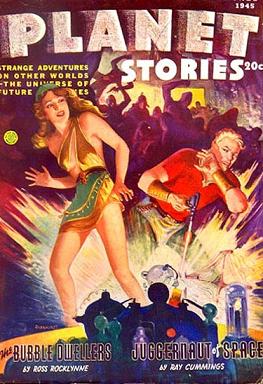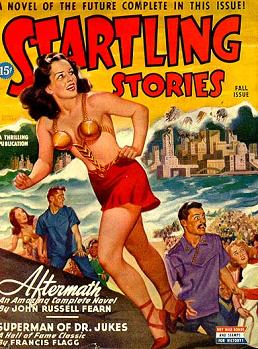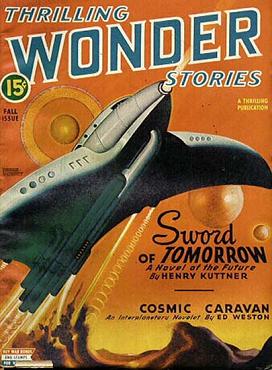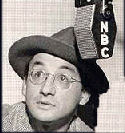
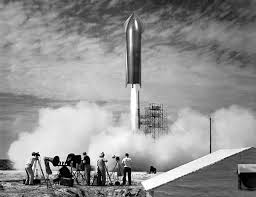 Lights Out (1934-47) aired “Rocket from Manhattan” on September 20, 1945, a mere six weeks following the first atomic bomb dropped on the Japanese city of Hiroshima on August 6, 1945. Written by radio’s wunderkind Arch Oboler (1909-1987), it is one of–if not the–very first drama anywhere to deal directly with aspects of the new Atomic Age (as dated from the Hiroshima bombing). The story begins with an “airship” (later called “rocketship”) as it returns to Earth after making it to the moon for the very first time. (Coincidentally, this episode aired on September 20, 1945, it takes place on September 20, 2000, and we find ourselves showcasing it here on September 20, 2014.) What the astronauts encounter upon their return, and before their landing back on Earth, forms the message of the story. And message heavy it is, as its cautionary warning would be the first of many in radio, on film, and in magazines and books during the remaining years of the 1940s and into the 1950s, as humanity sought to grapple with the upside, and possible dangers of atomic power and possible atomic war. As you will hear, much of the science in “Rocket from Manhattan” is simple-minded, just plain wrong, or deals with an aspect of atomic power many leading scientists of the time were unsure of. But it is Oboler’s message that takes center stage here, so we can perhaps forgive him his lack of fundamental science.
Lights Out (1934-47) aired “Rocket from Manhattan” on September 20, 1945, a mere six weeks following the first atomic bomb dropped on the Japanese city of Hiroshima on August 6, 1945. Written by radio’s wunderkind Arch Oboler (1909-1987), it is one of–if not the–very first drama anywhere to deal directly with aspects of the new Atomic Age (as dated from the Hiroshima bombing). The story begins with an “airship” (later called “rocketship”) as it returns to Earth after making it to the moon for the very first time. (Coincidentally, this episode aired on September 20, 1945, it takes place on September 20, 2000, and we find ourselves showcasing it here on September 20, 2014.) What the astronauts encounter upon their return, and before their landing back on Earth, forms the message of the story. And message heavy it is, as its cautionary warning would be the first of many in radio, on film, and in magazines and books during the remaining years of the 1940s and into the 1950s, as humanity sought to grapple with the upside, and possible dangers of atomic power and possible atomic war. As you will hear, much of the science in “Rocket from Manhattan” is simple-minded, just plain wrong, or deals with an aspect of atomic power many leading scientists of the time were unsure of. But it is Oboler’s message that takes center stage here, so we can perhaps forgive him his lack of fundamental science.
We must remember, when listening to programs like this or reading books about the subject during the same time period, that the subject matter was something totally new in the minds of the public–and the world. It was unexplored territory to the common man, and questions of every conceivable kind were leveled at the newly created beast of Atomic Power and its destructive capabilty. People were justly afraid of its power in the wrong hands, and even if perhaps a single blast could set off a chain reaction in the atmosphere, thus wiping out everyone on the planet in a matter of moments.
Arch Oboler took over from Lights Out creator Wyllis Cooper in 1936, to great success. Oboler stated that while he enjoyed writing and directing for Lights Out, he did it so he could afford more serious projects like his own Arch Oboler’s Plays, which dealt with important social and political issues of the day. Born of Jewish-Latvian immigrant parents who settled in Chicago, Oboler was a rabid anti-Nazi long before World War II. He also spoke out against war in general, as evidenced by his radio play “Johnny Got His Gun” from 1940; while several 1940s radio episodes ended in Hitler getting his comeuppance in gruesome deaths. So it should be no real surpirse that Oboler would infuse his view of atomic power and the bomb into the usually harmless, melodramatic, gory horror/supernatural atmosphere prevalent in Lights Out. It is a product of its time and writer/director.
 Factoid: The first plant life to reappear following the atomic bombing of Hiroshima was the oleander (aka nerium), which is now the official flower of the city. Origin believed to be in the Middle East, or possibly Asia, it is poisonous in all aspects, from leaves to stem to flower, and has always been thus. Quite the ironic flower to have been hardy enough to grow back after an atomic bomb laid waste to plant and animal over an entire city, and even more ironic that a poisonous flower is now the symbol of the city and its population destroyed not only by the initial blast, but by the poisonous radiation.
Factoid: The first plant life to reappear following the atomic bombing of Hiroshima was the oleander (aka nerium), which is now the official flower of the city. Origin believed to be in the Middle East, or possibly Asia, it is poisonous in all aspects, from leaves to stem to flower, and has always been thus. Quite the ironic flower to have been hardy enough to grow back after an atomic bomb laid waste to plant and animal over an entire city, and even more ironic that a poisonous flower is now the symbol of the city and its population destroyed not only by the initial blast, but by the poisonous radiation.
Play Time: 28:20
{Following this dark, cautionary episode of Lights Out, young readers could turn to more optimistic, adventurous fare in their science-fiction magazines, examples of which from Fall 1945 are shown below.}
[Left: Planet Stories, Fall 1945 — Center: Startling Stories, Fall 1945 — Right:Thrilling Wonder Stories, Fall 1945]
